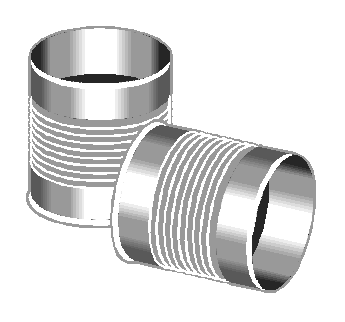|
|
|
|
|
|
|
|
|
|
|
|
|
|
|
|
|
|
|
|
|
|
|
|

|
|
|
|
|
|
|
|
|
|
|
|
|
|
|
|
|
|
|
|
|
|
|
|
|
|
|

|
|
|

The next thing to go in my survival kit is an empty tin can. That's right a tin can. Simple, yet it has so many uses. It can be used as a signal mirror. It can be a cup. Or it can be a pot for boiling water to purify it. Or it could be used to boil up greens or roots for food.
According to canned food makers, cans nowadays are specially lined to keep acidic foods like tomatoes from causing the metal to leach into the food. If you keep them full of water, this liner will even withstand boiling.
You could take your can full of peaches, if you didn't mind the weight. I always have a P-38 can opener on my keyring. Open the lid so that it is still attached by an inch of can, and roll the lid back- don't cut yourself- so that you can poke a stick into to rolled lid and pick the can full of liquid off the fire.

You could take the empty can and drill 4 equidistant holes right near the top rim. Then put wire through them and twist the two ends of wire to make a handle. A stick poked through the handle can lift the can full of tea off of a fire.
Containers that hold water are tough to make in the wilderness. The Indians had four basic ways to do it.
1. Basket:
Squaws were both practiced and talented so that they could make baskets, usually lined with pitch, that were water-tight. To make soup or tea, they would make a fire over smooth round stones, (not river stones that could have trapped water and explode,) and heat them. Then, with a stick whittled into a pair of tongs, they would drop the hot rocks into the basket until it boiled the water. Sounds simple, I haven't tried it.
2. Animal Parts:
The stomach of an animal was thoroughly cleaned, tied at one end, and a sling-like carrier made for it to carry water. The next deer I harvest, I'll make one to show you. Hides were sometimes used to boil soup in. A hole was dug in the ground and lined with the hide- flesh side in. The soup was then boiled using the fire-heated rock method. I guess this was the original "stone soup!"
3. Wooden Bowls:
Wooden bowls were made by taking a cut section of wood or a burl and alternately putting coals on it and carving it out to make a depression.
4. Clay Bottles:
Where clay was plentiful and accessable, the Indians would make clay bottles and bowls.
Those were how the Indians coped with entirely natural materials. As you can see, liquid containers were hard to come by. Indians really valued trading for iron pots when the white men came along. That's why the Can-Do Can is such a marvellous item. When you are scratching in the wilds, you will come to appreciate the humble can.